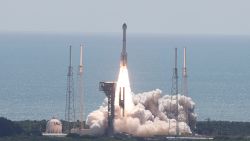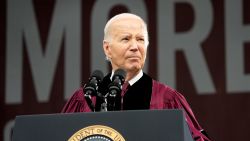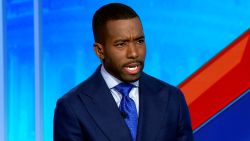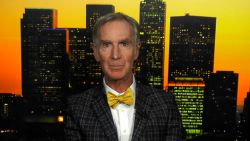Fears of a brewing global recession were renewed this week as markets whipsawed over President Donald Trump’s trade war with China as well as disappointing economic data from both Germany and China.
The US economy, for now, remains on solid ground with strong consumer spending propping up the country’s longest expansion, now in its 11th year, despite weak business investment and a slowdown in manufacturing. Since Trump took office, paychecks have grown, the stock market has reached record highs and unemployment has stayed at a historic 50-year low.
But like the adage goes: “Economic expansions don’t die of old age.” Something has to happen to spook businesses, consumers and investors.
It’s hard to predict exactly if, or when, a recession could hit the United States. But the trigger could be a number of factors – Trump’s trade policy, a weakening global economy, the waning effects of the 2017 tax cuts, or even a calamitous risk of deflation.
Here’s a look at the top five risks that could set off a US downturn:
1. A pullback in consumer spending
With business investment slowing, consumers are powering the US economy.
The money Americans spend each day on coffees, cars and clothing helps to account for about two-thirds of economic growth. And the fact that Americans haven’t shied away from spending at a solid clip this year despite a turbulent trade war with China has helped to balance out weaknesses in other pockets of the economy.
Retail sales – economic data that captures spending at stores, restaurants and online – popped in July, according to the Commerce Department on Thursday, the strongest reading since March in part due to Amazon’s Prime Day and other retailer promotions. Walmart, a bellwether of US consumer spending, also reported strong sales at its jumbo-sized stores and upped its forecast for the rest of the year.
But worries about a future downturn can also have the effect of becoming a self-fulfilling prophecy. As consumers start to worry about the possibility of a worsening economy, it’s usually followed by a desire to quit spending as much and delay bigger purchases.
2. An escalation with China
Trump’s on-again, off-again trade war with China has left US importers – as well as farmers hit by Beijing’s retaliatory tariffs – unsure about what comes next. That has already slowed investment decisions by US businesses, and will likely continue for some time.
In an effort to avoid harming the holiday shopping season, the Trump administration agreed this week to throttle back on plans to impose 10% tariffs on $300 billion of Chinese goods that were set to go into effect on September 1. But men’s and women’s clothing items, some electronics and sporting goods from China will all still be hit by a 10% levy starting in about two weeks.
Beijing threatened to take retaliatory action this week, despite the pullback on most of the tariffs facing Chinese-made cell phones and toys. “China would have no choice to take necessary countermeasures,” according to a statement from the country’s State Council’s Customs Tariff Commission.
Goldman Sachs and other analysts no longer expect the Trump administration to reach a trade deal with China ahead of the 2020 election, and anticipate far deeper economic effects due to the trade war.
3. A global slowdown
Five of the world’s biggest economies are now at risk of a recession – and the spillover effect could eventually drag the US economy down, too.
Germany, the world’s fifth largest economy, reported that its economy shrank in the second quarter, opening up the possibility that it might tip into a full-blown recession. It was joined by the United Kingdom, whose economy also contracted for the first since 2012.
The International Monetary Fund last month cut its forecast for global growth this year to 3.2%, the weakest rate of expansion since 2009. It also downgraded its expectations for 2020 to 3.5%.
The fund has warned that growth in 2020 would be slashed by half a percentage point if the trade dispute escalates further.
In response, central banks around the world have been trimming interest rates this year to head off a global economic slowdown. Last week, three central banks – India, New Zealand and Thailand – all aggressively cut rates more than expected over trade fears and growing economic uncertainty.
4. Too little inflation
Inflation has been remained historically low both in the United States and around the world. It’s one of the reasons that Federal Reserve Jerome Powell has cited for cutting rates for the first time since the 2008 financial crisis.
Central bankers consider low inflation dangerous because it tends to weigh on interest rates, giving them less room to juice the economy during a recession. That’s what happened in Japan, which has struggled for years to kickstart growth.
“We don’t want to get on that road,” Powell warned lawmakers in July.
The latest report this week showed US inflation ticking slightly upward, providing some comfort to policy makers worried about deflation. But a slowdown abroad could push energy prices lower, making it harder for policymakers to keep the US economy on the steady 2% inflation track, a sign of a healthy economy.
5. The big unknown: Brexit
The decision by Britain’s new prime minister, Boris Johnson, to abandon efforts to negotiate a “soft Brexit” with the European Union has created additional global economic uncertainty.
Johnson has pledged that the UK would leave the European Union on October 31 with or without a deal, raising concerns about shortages of food and medicine. While the British economy is expected to rebound in the third quarter bypassing a recession, the decision to pull out of the EU without a deal might trigger a downturn that would further accelerate a global slowdown.






















